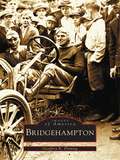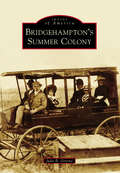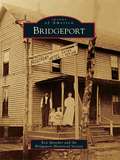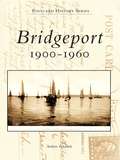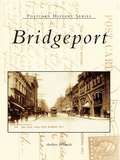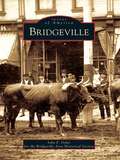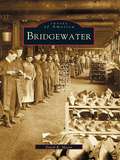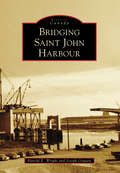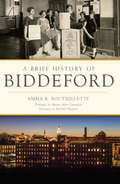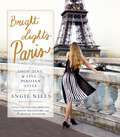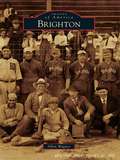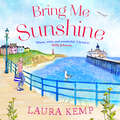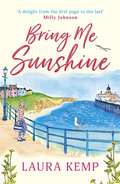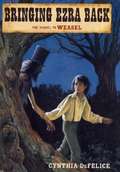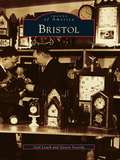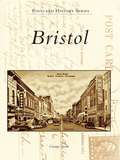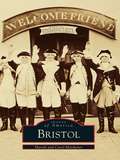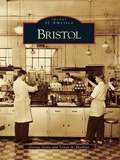- Table View
- List View
Bridgehampton (Images of America)
by Geoffrey K. FlemingBridgehampton is a fascinating look at one of the prime resort areas on the South Fork of Long Island. The history of Bridgehampton was captured magnificently by studio and itinerant photographers whose work from the mid-1800s to the late 1900s is reflected here. These stunning images show people as they raised children, worked on the farm, worshiped, studied, socialized, and played. The faces show expressions of pride, joy, and, occasionally even boredom, providing a realistic portrayal of the past.
Bridgehampton's Summer Colony (Images of America)
by Julie B. GreeneThe hamlet of Bridgehampton was settled in 1656 and aptly named for the bridge that was built to connect the settlements of Mecox and Sagaponack. Ninety miles from New York City, this rural farming community was transformed by the arrival of the Long Island Rail Road in 1870. With the notion that salt air and sea breezes were the perfect relief from the hot and sweltering isle of Manhattan, wealthy New Yorkers made the sojourn to the pristine shores of the Atlantic Ocean. On a trip down Ocean Road toward the beach, one would pass the grand homes of a toy importer, a pen manufacturer, a coal industrialist, a merchant tailor, and an inventor--the established summer colony. The region quickly gained a reputation as a pleasant summer resort--a reputation that still thrives today.
Bridgeport (Images of America)
by Bridgeport Historical Society Ken SprecherIn 1860, John Butterfield rerouted his famous stage line over the west fork of the Trinity River, and soon a small community sprang up along the banks near the new toll bridge. The settlement became known as Bridgeport, and its pioneers found themselves in the middle of both Texas and American history. Since then, Bridgeport's contributions to history have been achieved through the area's land, as well as the rich oil that flowed beneath the rugged, cactus-dotted country. Recognizing the importance of the earth and what lay below took the skill of entrepreneurs and the hard work of many people. The cast of pioneer characters included a young, well-educated New Yorker seeking adventure in the new republic, a stern but generous engineer from Pennsylvania, and a billionaire wildcatter from Houston. Not forgotten are the stories of immigrants from all over the world whose lives have enriched Bridgeport's historic past. Today Bridgeport continues to utilize natural resources while developing its local heritage and ecotourism sites.
Bridgeport: 1900-1960
by Andrew PehanickBridgeport: 1900-1960 presents a fascinating look into the history of Bridgeport through vintage postcards from the city's formative years. These vintage postcards depict the change and expansion in Bridgeport during the 20th century, from the growth of the University of Bridgeport from a small junior college into a major university to the changes in transportation from the horse and buggy to early automobiles and trolley cars. Bridgeport's waterfront played an important role in the development of the city, drawing visitors and wealthy residents who built homes along the shore. Following the two world wars, the city saw a large population increase, and a building boom soon followed. Factories and homes were built, retail stores moved in, and recreational options increased to serve the needs of the thousands of people who came to Bridgeport seeking employment.
Bridgeport: 1900-1960 (Postcard History)
by Andrew PehanickThe golden age of postcards, which took place between 1900 and 1940, was also the golden age of Bridgeport. Local and national publishers printed scenes of the city's beautiful and renowned parks, magnificent mansions, palatial theaters, and sprawling factories, as well as its busy streets and unique architecture. These cards carried images of Bridgeport near and far. Recipients of these mementos could imagine building automobiles at the Locomobile factory, dining at the Amazon Caf©, staying at the Stratfield Hotel, riding the carousel at the Steeplechase Island amusement park, shopping at Howlands, admiring the Wheeler Mansion, attending mass at the South Congregational Church, or watching the activity at the winter quarters of the Ringling Brothers and Barnum & Bailey Circus. Bridgeport takes the modern reader on a journey into the past through nearly two hundred of these vintage postcard images.
Bridgeville (Images of America)
by John F. Oyler Bridgeville Area Historical SocietyBridgeville has a rich historical heritage dating back to Colonial times. In the early 1800s, a small village grew along the meandering Chartiers Creek between two bridges on the Black Horse Trail. The construction of the Chartiers Valley Railroad, the establishment of the Norwood Hotel, and the opening of commercial bituminous coal mines in the region generated a population boom that motivated residents to seek autonomy from Upper St. Clair Township. In 1901, the borough of Bridgeville was incorporated, and the next 50 years saw the community become the social and business center for the four neighboring townships with schools, churches, and a bustling downtown business environment. Bridgeville remains close enough to Pittsburgh to enjoy the cultural advantages of a big city, yet far enough away to retain the feel of a small hometown.
Bridgewater
by David R. MooreNot long after the Pilgrims came ashore, Bridgewater became the first inland settlement to branch out from the Plymouth Colony, incorporating in 1656. Its fertile soil and bountiful rivers provided for a rich agricultural community. As the Industrial Revolution forced farmers into factories, Bridgewater experienced rapid social and economic growth and change. Iron, shoe, and paper manufacturing flourished, and the railroad brought European immigrants in search of the American Dream. In Bridgewater, vintage images tell the stories of the Bridgewater Academy, the normal school, the changes in and around the common, the business pursuits of local proprietors, and the spiritual and civic life of Bridgewater residents.
Bridgewater (Images of America)
by Bob F. Holton Carleen LovelessThe story of Bridgewater is one of survival. Since its founding in 1835, this community has endured six major floods, economic crises, and a war that took place on its own soil. Despite the adversity it faced, the town has not only prevailed but has grown into one of the strongest and most progressive towns in Virginia.
Bridging Saint John Harbour (Historic Canada)
by Harold E. Wright Joseph GoguenIn the 1850s, lumber mill owner W. Kilby Reynolds, with engineer Edward R. Serrell, succeeded in building the first suspension bridge to connect divided Saint John. This operated as a toll crossing until 1858, when it became a government-owned structure. From then until the present, there have been two vehicular-pedestrian bridges and two rail bridges serving travelers crossing Saint John Harbour at the gorge at the Reversing Falls. By the third quarter of the 19th century, there was talk and plans for a second bridge, one which would cross at Navy Island to the North End. It took about 80 years before this plan came to fruition, and the Saint John Harbour Bridge opened in 1968. Through this rich collection of photographs, Bridging Saint John Harbour clearly shows the importance of the varied connector bridges over Saint John Harbour and how they came to be built.
Bridgton (Images of America)
by Ned AllenIn 1768, Jacob Kimball moved to the shores of Long Lake in North Bridgton, building a store and providing boat service from Standish, at the southern end of Sebago Lake. Jacob Stevens soon followed, building a sawmill and gristmill on what became Stevens Brook in the center village. Ten power sites on this short brook ran lumber, textile, and other mills, as well as a tannery. Bridgton became the area's commercial center as retail stores and businesses sprang up to support the many mill workers and farm families. The first train on the narrow-gauge Bridgton and Saco River Railroad chugged into town in January 1883. Tourists and artists soon discovered Bridgton, and today the town remains a diverse mix of creative, hardworking people.
Brief History of Biddeford, A (Brief History)
by Emma R. Bouthillette Epilogue By Poupore Prologue By CasavantCaptain Richard Vines founded Winter Harbor in 1616. The small coastal village, now known as Biddeford, is the largest city in York County, with more than twenty-one thousand residents. During the nineteenth century, the city experienced a boom from the textile industry when textile magnate Samuel Batchelder established Pepperell Manufacturing Company, which rapidly became an international brand. The city suffered when textile manufacturing moved south in the mid-twentieth century, abandoning its expansive infrastructure along the Saco River. In 2004, Mayor Wallace Nutting organized local residents in a revitalization effort for the downtown area, and developers renovated historic mill buildings into residential and commercial space. Join author and lifelong Biddeford resident Emma Bouthillette as she revisits the city’s early history and explores its recent rebirth.
Brief History of Fayetteville Arkansas, A (Brief History)
by Charles Y. AlisonOriginally a small town called Washington Courthouse, Fayetteville bloomed into one of Arkansas’s largest cities. The town prospered during its first two decades, until it suffered decimation during the Civil War as troops moved throughout the region. In 1871, Fayetteville successfully bid to be home to the University of Arkansas, the state’s first public university. Today, the city represents a cultural convergence, with remnants of historic trails such as the Military Road between St. Louis and Fort Smith and the Trail of Tears. Author and historian Charlie Alison details pivotal events that shaped the city.
Brief Loves That Live Forever
by Andreï Makine Andrei MakineIn Soviet Russia the desire for freedom is also a desire for the freedom to love. Lovers live as outlaws, traitors to the collective spirit, and love is more intense when it feels like an act of resistance. Now entering middle age, an orphan recalls the fleeting moments that have never left him - a scorching day in a blossoming orchard with a woman who loves another; a furtive, desperate affair in a Black Sea resort; the bunch of snowdrops a crippled childhood friend gave him to give to his lover. As the dreary Brezhnev era gives way to Perestroika and the fall of Communism, the orphan uncovers the truth behind the life of Dmitri Ress, whose tragic fate embodies the unbreakable bond between love and freedom.
Bright Lights Paris: Shop, Dine & Live...Parisian Style
by Angie NilesTake a life-changing journey with a fashion insider through the neighborhoods of Paris—and become the most glamorous girl in town (without even trying). After spending much of her life mining the secrets of La Parisienne, Angie has discovered there are as many ways to be Parisian as there are arrondissements. Find out what Saint Germain women wear, where Canal Saint Martin girls shop and hang out with their friends, the décor tricks of the artistic ladies in Montmartre, and how to cook and entertain—as if you just rolled out of bed and onto the cobblestone streets of Le Marais… Featuring hundreds of stunning photographs and original fashion illustrations, as well as fabulous tips from celebrities, fashion designers, bloggers, chefs, and more!
Bright Unbearable Reality: Essays
by Anna Badkhen2022 National Book Awards Longlist for Nonfiction Essays about migration, displacement, and the hope for connection in a time of emotional and geopolitical disruption by a Soviet-born writer and former war correspondent.Called a &“chronicler of a world on the move&” by The New York Review of Books, Anna Badkhen seeks what separates and binds us at a time when one in seven people has left their birthplace, while a pandemic dictates the direst season of rupture in humankind&’s remembering. Her new essay collection, Bright Unbearable Reality, comprises eleven essays set on four continents—roving everywhere from Oklahoma to Azerbaijan—and united by a common thread of communion and longing. In these essays, Badkhen addresses the human condition in the era of such unprecedented dislocation, contemplates the roles of memory and wonder in how we relate to one another, and asks how we can soberly and responsibly counter despair and continue to develop—or at least imagine—an emotional vocabulary against depravity. The subject throughout the collection is bright unbearable reality itself, a translation of Greek enargeia, which, says the poet Alice Oswald, is &“when gods come to earth not in disguise but as themselves.&” Essays include: • In &“The Pandemic, Our Common Story,&” which takes place in the Great Rift Valley of Ethiopia, one of the locations where humankind originated, the onset of the global pandemic catches Badkhen mid-journey, researching human dispersal 160,000 years ago and migration in modern times. • In &“How to Read the Air,&” set mostly in Philadelphia, Badkhen looks to the ancient Greeks for help pondering our need for certainty at a time of racist violence, political upheaval, and environmental cataclysm. • &“Ways of Seeing&” and the title essay &“Bright Unbearable Reality&” wrestle with complications of distance and specifically the bird&’s eye view—the relationship between physical distance, understanding, and engagement. • &“Landscape with Icarus&” examines how and why children go missing, while &“Dark Matter&” explores how violence always takes us by surprise.
Brighton
by Albin WagnerThe town of Brighton was founded by railroad man and real estate developer Daniel F. Carmichael at the junction of the Denver Pacific (now Union Pacific) and Denver and Boulder Valley Railroads. Carmichael determined, "There should be a town here that would do credit to the splendid valley." The junction, originally named Hughes after the first president of the Denver Pacific Railroad, had a long history as a crossroads of the West. The town grew into an agricultural center for the Platte River Valley with a thriving sugar beet industry, dairies, and canning factories, but the changing economy would transform Brighton first into a suburban community and now into one of the fastest-growing cities in the United States.
Bring Me Sunshine: The perfect heartwarming and feel-good book to curl up with this year!
by Laura KempCharlotte Bold is nothing like her name - she is shy and timid and just wants a quiet life. When her job doing the traffic news on the radio in London is relocated to Sunshine FM in Mumbles, she jumps at the chance for a new start in Wales. But when she arrives she discovers that she's not there to do the travel news - she's there to front the graveyard evening show. And she's not sure she can do it.Thrust into the limelight, she must find her voice and find a way to cope. And soon she realises that she's not the only person who finds life hard - out there her listeners are lonely too. And her show is the one keeping them going.Can Charlotte seize the day and make the most of her new home? And will she be able to breathe new life into the tiny radio station too...?Read by Lowri Walton(p) Orion Publishing Group 2019
Bring Me Sunshine: The perfect heartwarming and feel-good rom-com to curl up with this year!
by Laura Kemp'A delight from the first page to the last' Milly Johnson, Sunday Times bestselling author of The Magnificent Mrs Mayhew'Laugh-out-loud funny, as warm as it is witty...If you love Milly Johnson you will love Laura Kemp' Debbie Johnson, bestselling author of The Comfort Food Café seriesCharlotte Bold is nothing like her name - she is shy and timid and just wants a quiet life. When her job doing the traffic news on the radio in London is relocated to Sunshine FM in Mumbles, she jumps at the chance for a new start in Wales. But when she arrives she discovers that she's not there to do the travel news - she's there to front the graveyard evening show. And she's not sure she can do it.Thrust into the limelight, she must find her voice and a way to cope. And soon she realises that she's not the only person who finds life hard - out there her listeners are lonely too. And her show is the one keeping them going.Can Charlotte seize the day and make the most of her new home? And will she be able to breathe new life into the tiny radio station too...?Praise for Bring Me Sunshine:'An absolute joy. Five stars' Isabelle Broom, Heat'A truly wonderful and heartwarming read' Heidi Swain'It will make you giggle, cheer and feel good - basically it's a hug in book form. Hugely recommended' Fabulous Magazine'It's brilliant, so fresh and funny' Katy Regan
Bring Me Sunshine: The perfect heartwarming and feel-good rom-com to curl up with this year!
by Laura Kemp'A delight from the first page to the last' Milly Johnson, Sunday Times bestselling author of The Magnificent Mrs Mayhew'Laugh-out-loud funny, as warm as it is witty...If you love Milly Johnson you will love Laura Kemp' Debbie Johnson, bestselling author of The Comfort Food Café seriesCharlotte Bold is nothing like her name - she is shy and timid and just wants a quiet life. When her job doing the traffic news on the radio in London is relocated to Sunshine FM in Mumbles, she jumps at the chance for a new start in Wales. But when she arrives she discovers that she's not there to do the travel news - she's there to front the graveyard evening show. And she's not sure she can do it.Thrust into the limelight, she must find her voice and a way to cope. And soon she realises that she's not the only person who finds life hard - out there her listeners are lonely too. And her show is the one keeping them going.Can Charlotte seize the day and make the most of her new home? And will she be able to breathe new life into the tiny radio station too...?Praise for Bring Me Sunshine:'An absolute joy. Five stars' Isabelle Broom, Heat'A truly wonderful and heartwarming read' Heidi Swain'It will make you giggle, cheer and feel good - basically it's a hug in book form. Hugely recommended' Fabulous Magazine'It's brilliant, so fresh and funny' Katy Regan
Bringing Ezra Back
by Cynthia C. DefeliceIn the mid-1800s, twelve-year-old Nathan journeys from his farm on the Ohio frontier to Western Pennsylvania to rescue a friend held captive by the owners of a freak show.
Bristol
by Steven Vastola Gail LeachBristol was originally a tightly held and uninhabited portion of Farmington and was known in its early days as the West Woods. Settlers did not arrive until the 1720s and, after building their small community, they sought and received status as the New Cambridge Parish in 1742. Their numbers continued to grow and, by 1785, the community joined neighboring West Britain Parish in separating from Farmington and becoming the town of Bristol. Bristol tells the story of the people, places, and events that transformed this small agricultural hamlet into a true industrial city. The waters of the Pequabuck River brought industry, which soon surpassed farming as the residents' primary livelihood. Bristol became the source of many important products-clocks, springs, silverware, coaster brakes, doorbells, automobiles, roller bearings, and fishing rods, to name a few. In following this evolution, Bristol highlights the residents and workers, their homes and places of business, their entertainment and modes of transportation.
Bristol
by George StoneIn 1852, Joseph R. Anderson purchased 100 acres on the Virginia-Tennessee border with the intent of building a town in the foothills of the Appalachian Mountains. Four years later, Bristol was incorporated, and it celebrated its 150th birthday in 2006. Taking its name from the English city, Bristol is also known as the Twin City because of its two distinct towns with two separate governments--one in Virginia and the other in Tennessee. Postcard History Series: Bristol portrays the city from the late 1800s through its growth during the 20th century and preserves its rich heritage in vintage postcards.
Bristol
by Richard V. SimpsonBristol, a shire town in the smallest county in the smallest state, is nestled between the Narragansett and Mount Hope Bays. Most of the town is surrounded by water, and its history lies therein. Bristol is ever changing, yet it manages to retain a small hometown character. This nostalgic postcard history of Bristol leads readers down dusty, mid-19th-century streets and into the bustling mid-1950s historic center. Today, people sail leisurely into Bristol's snug harbor, dock at the many public landings, and dine on the waterfront. Other visitors stroll down tree-lined streets, take in the many beautiful seascapes, or marvel at the aristocratic 18th-century homes built by wealthy merchants, slavers, and privateers.
Bristol (Images of America)
by Harold Mitchener Carol MitchenerBristol traces its roots to a grant obtained by Samuel Clift in 1681, William Penn's establishment of an estate one year later, and to its location along prime transportation routes. Situated below the fall line of the river and along the main route for land travel, Bristol afforded direct access between Philadelphia and New York City. As more people and businesses started to call the new settlement home, Bristol began to find its place in history. Bristol is a pictorial journey to the roots of one of America's oldest towns. The book beautifully illustrates its development from a countryside encampment, to the government seat of Bucks County, to the setting of major industry. The growth of Bristol is portrayed through the development of its municipal services, organizations, and entertainment facilities. Furthermore, these images attest to the way Bristol responded to conflict, from the Civil War to World War II, by providing ships, airplanes, and its own heroes. A remarkable collection of images from theMargaret R. Grundy Memorial Library and other sourcestells the story of a truly unique place.
Bristol (Images of America)
by Sonya A. Haskins George StoneImages of America: Bristol celebrates the history of the town known as "A Good Place to Live." Joseph A. Anderson bought land on the Virginia-Tennessee border from his father-in-law, Rev. James King, and founded Bristol in 1852. Just four years later, the Virginia and Tennessee Railroad came to Bristol, and the town became a major trading center of the Appalachian region. During the Civil War, Bristol was a vital railway link between the North and the South, and it later became known as the birthplace of country music. Readers are sure to enjoy viewing over 200 vintage photographs of the train station, the Carter Family, the King family, Virginia Intermont College, and King College, as well as homes and people from all walks of life. The S. E. Massengill drug manufacturing company shown on the cover is among the highlighted industries.
